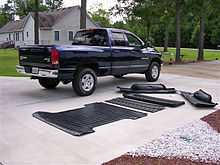Truck bedliner


Truck bed liners are protective coatings that shield the inner-side of a truck bed from damage and also create a skid resistant surface allowing any cargo to stay in place, depending on circumstances. There are two broad classifications of Bed liners: "Drop-in" and "Spray on/in". "Drop-in " bed liners are easily applied to the truck bed with no preparation work required, and can be easily removed as well for cleaning. Spray-in liners require specific preparation to allow the coating to adhere correctly to the bed, the better the coating can adhere will determine the length of life for the coating.
"Sprayed On","Sprayed In","Spray On", "Spray In" (these terms are used interchangeably in the industry) come in two classes of material and two main types of application processes: aromatic and aliphatic compounds applied through a Low pressure (not heated) or high pressure (heated) process. Performance greatly relies on the initial surface preparation done on the bed, it is now possible to have color matching bed liners to your vehicle, within time UV radiation is inevitable.
Aromatic is generally used for black and darker colors, and is the least expensive option.
Aliphatic can be a better option for colors because it is UV stable. It is produced with pure polyurethane, driving cost up approximately 35%. Aliphatic materials can be sprayed in a wide variety of colors, including metallic finishes.
Spray-on bed liners can be applied by roller, low pressure, cartridge driven by an air compressor or high pressure machine.
Environmental conditions such as humidity, temperature, wind, and elevation can affect the cure process of a spray in bedliner. Such things as nozzle aperture, thinners and spray pressure are modified to allow for proper distribution of the spray lining chemicals.
Differences in Spray in Bed liners
Spray on bed liner material can vary in texture as well as color. Texture can be smooth for easy cleaning or rough to prevent skidding.
Polyurethane can be sprayed from 1/16 inch to 4 inches, depending on the application. Thinner coatings may cost less but can chip and crack. Thicker coatings destroys the shape and size of the truck bed. For trucks with the most rugged use, ArmorThane sets optimum thickness for bed liners as 1/4 inch on the bed and wheel wells and 1/8 inch on the sides.
When applied correctly, the value of a truck bed liner is that it resists denting and scratching and holds shape firmly yet is flexible enough to not crack when navigating through rough terrain. Unlike a metal bed, it absorbs vibration to protect cargo. Whereas painted metal will chip and rust under rough conditions, polyurethane coatings prevent damage from scratching and most chemicals and therefore avoid rusting.
Spray on truck bed liners require a professional applicator who has the training and experience to follow the process and deliver a smooth, even surface. The process requires sanding to create a surface for the polyurethane to attach. This allows the polyurethane to bond permanently so it will not bubble even in extreme weather.
The choice of colors is virtually unlimited. A color matching system sprays to OEM specs or owners can choose custom colors. Adding a UV stabilizer maintains the appearance even in prolonged direct sunlight.
Spray on Bed Liner Material for Other Uses

These spray on polyurethane coatings are not just for truck bed liners. They also protect fenders, bumpers, floor boards, nerf bars and trim. In fact, whole vehicles have been sprayed. The same polyurethane spray can be applied to emergency vehicles, commercial transport, heavy construction, agriculture equipment and boats.
Spraying polyurethane serves two purposes. First, it adds years of service by preventing scratching, rusting, and chemical contamination from deteriorating standard OEM paint. Second, it can create a roughed up, anti-skid or anti-slip surface.
Some polyurea coatings, using a similar spray system, have been applied to military and private vehicles for blast mitigation.
The MythBusters tested myths about bed liner in 2011 and confirmed it to be an adequate protection against dents in minor crashes (applied on a car), dog bites (applied on a jacket) and explosive blasts (applied on a wooden or brick wall).[1]
Polyurethane Spray Bed liners
In the bedliner industry there is confusion created from all the custom polyurea, polyurethane and polyurea formulations. Each company boasts of its superior durability and profitable dealer opportunities. The reality, they are all very similar once you get away from low quality do it yourself products. If you want to learn about the differences between spray bedliners, in understanding the differences between polyurethane and polyurea as well as what is required to achieve different textures and physical properties. Polyureas and polyurethanes have significant differences chemically, but act similarly in many applications. For the purpose of bed liners the big difference is in the applications process and the level of iso's and VOCs. This is an important aspect of the bed liner industry as VOC's and isocyanates prevent the application of spray bed liners in many states or place restrictions on how the material can be applied.

Other Applications
Only two types of coatings are mentioned so far but additives can be added to coatings to provide different characteristics, Although this is about Truck Bed Liners, the protective coatings can be applied in many other environments have a variety of needs and purposes besides a simple truck bed liner.
It is becoming more popular to coat the exterior of vehicles and boats. This is because there are more companies competing in these markets and hence developing better solutions. So, now you see companies like Rhino Linings, Line-X, Spray-lining.com and Scorpion providing solutions for exterior and colors. These solutions also transfer over to the interior of boats because of the waterproof and anti-corrosive properties that polyurethane and epoxy hold.